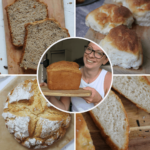Imagine crafting perfect, delicate strands of pasta, each bite a celebration of flavor and texture, all while adhering to a gluten-free lifestyle. This isn’t a dream; it’s the delicious reality achievable with the right knowledge and techniques. Unlock the secrets to creating a variety of gluten-free pastas at home, from simple rice flour noodles to elegant almond flour creations. Discover the ideal flour blends, master essential techniques, and explore a world of flavor combinations that will transform your culinary landscape.
This guide delves into the art of homemade gluten-free pasta, providing comprehensive instructions and insightful tips for achieving restaurant-quality results in your own kitchen. We’ll explore different gluten-free flour options, comparing their properties and guiding you towards optimal blends for achieving the perfect texture and taste. From basic recipes to advanced techniques, we’ll equip you with the skills to create a diverse range of pasta shapes and experiment with exciting flavor profiles. Whether you’re a seasoned cook or a kitchen novice, this guide will empower you to confidently create delicious and satisfying gluten-free pasta dishes.
Advanced Gluten-Free Pasta Techniques

Mastering gluten-free pasta making involves understanding techniques beyond basic recipes. This section delves into advanced methods for shaping pasta, managing dough consistency, and achieving optimal texture. The results are well worth the extra effort, yielding pasta that rivals its gluten-containing counterpart in both taste and appearance.
Creating Diverse Pasta Shapes
The versatility of gluten-free pasta dough allows for a wide array of shapes. Achieving these shapes requires specific techniques and tools. For instance, creating long, thin strands like spaghetti involves using a pasta machine with progressively narrower rollers. The dough, initially a thick sheet, is fed through the rollers repeatedly, gradually thinning and lengthening until it resembles a delicate ribbon. This ribbon is then cut into spaghetti-like strands using a cutter attachment. The finished product is a collection of long, cylindrical strands, each uniform in thickness and perfectly smooth.
For fettuccine, a wider, flatter pasta, the process is similar. The dough is passed through the rollers to a slightly thicker setting than spaghetti, resulting in a broader ribbon. This ribbon is then cut into wider strips, creating the characteristic fettuccine shape. Imagine the rich, golden hue of the fettuccine, each strand lying flat and slightly ribbon-like.
Ravioli, on the other hand, require a different approach. Here, the dough is rolled out thinly, and small squares are cut. A filling, such as ricotta cheese or vegetables, is placed in the center of each square. One corner is then folded over to meet the opposite corner, creating a triangular shape. The edges are firmly pressed to seal, forming the characteristic little pillow-shaped ravioli. The final product is a collection of perfectly formed ravioli, ready for boiling and enjoying. Their delicate, slightly pleated edges showcase the care taken in their creation.
The Importance of Dough Resting
Resting the gluten-free pasta dough is crucial. After mixing, the dough needs time to hydrate and develop its structure. This resting period, typically 30 minutes to an hour, allows the gluten-free flours to absorb the liquid fully. This leads to a more cohesive and less crumbly dough that is easier to roll and shape. Without resting, the dough might be too sticky or dry, resulting in uneven pasta and a less desirable texture after cooking. The resting process allows the starches to gelatinize, resulting in a smoother, more elastic dough. Imagine the difference between a hastily assembled structure and one that has been carefully planned and allowed to settle – the same principle applies to gluten-free pasta dough.
Achieving a Smooth and Consistent Dough
Several methods contribute to achieving a smooth and consistent gluten-free pasta dough. The traditional method involves using a stand mixer fitted with a dough hook. The mixer kneads the dough thoroughly, developing a consistent texture. The resulting dough is supple and smooth, free from lumps or dry patches.
Alternatively, a food processor can be used for a quicker mixing process. Pulse the ingredients until a shaggy dough forms, then carefully bring the dough together by hand to ensure even distribution of moisture. This method is quicker but requires more attention to ensure a smooth dough. Imagine the satisfying whirring of the food processor as the ingredients combine, quickly forming a smooth, consistent dough. The final dough is less elastic than the one made with a stand mixer, but it is still suitable for making pasta.
Regardless of the method, the key is to add liquids gradually, ensuring that the dough comes together smoothly. Over-mixing can lead to a tough pasta, while under-mixing will result in a crumbly dough. The ideal dough is pliable, smooth, and easy to handle, representing the perfect balance of hydration and structure.
Flavoring and Serving Suggestions for Gluten-Free Pasta
The delightful texture of perfectly cooked gluten-free pasta deserves to be paired with equally delicious sauces and toppings. The key to unlocking its full potential lies in understanding how different flavor profiles complement the subtle nuances of the pasta itself, and how to prevent it from sticking. A little creativity can transform a simple dish into a culinary masterpiece.
Creative Sauce and Topping Ideas
Choosing the right sauce and toppings can elevate your gluten-free pasta dish from ordinary to extraordinary. The following suggestions offer a diverse range of flavor profiles to inspire your culinary adventures. Remember to consider the texture and flavor intensity of your chosen pasta when making your selection.
- Creamy Sauces: Imagine a luscious creamy sauce, perhaps a vibrant sun-dried tomato cream sauce with bursts of sweet and savory notes, or a delicate mushroom cream sauce with earthy undertones and a hint of garlic. These rich sauces cling beautifully to the pasta, creating a satisfying and comforting dish.
- Tomato-Based Sauces: The classic simplicity of a fresh tomato sauce, punctuated with fragrant basil and a touch of oregano, is a timeless pairing. For a more complex flavor, consider a slow-simmered marinara with roasted vegetables, adding depth and sweetness to the dish. A spicy arrabbiata sauce offers a fiery kick, perfectly balanced by the pasta’s mildness.
- Pesto Sauces: The vibrant green of a classic basil pesto, its fragrant aroma hinting at garlic and pine nuts, is a refreshing and flavorful choice. Experiment with variations like sun-dried tomato pesto or kale pesto for unique flavor profiles. The pesto’s herbaceous notes complement the pasta beautifully, providing a bright and satisfying contrast.
Preventing Gluten-Free Pasta from Sticking
Gluten-free pasta can sometimes be prone to sticking, but this is easily remedied with a few simple techniques. The key is to ensure the pasta is well-coated in liquid and cooked according to package directions.
- Reserve Pasta Water: Save about a cup of the starchy cooking water before draining the pasta. Adding a few tablespoons of this water to your sauce helps create a creamy consistency and prevents the pasta from sticking together.
- Toss Immediately: Once drained, immediately toss the pasta in your sauce. The heat from the pasta helps the sauce coat each strand evenly, preventing sticking. Work quickly to ensure even distribution.
- Use a Non-Stick Pan: Cooking the pasta in a large, non-stick pan can help prevent sticking, especially if you are adding your sauce directly to the pan after cooking the pasta.
Flavor Enhancement with Herbs, Spices, and Vegetables
Adding herbs, spices, and vegetables is a simple yet effective way to enhance the flavor of your gluten-free pasta. Think of it as painting a culinary canvas with layers of taste and texture.
- Herbs: Fresh herbs like basil, parsley, oregano, and thyme add brightness and aromatic complexity. Experiment with different combinations to create unique flavor profiles. A simple sprinkle of fresh herbs just before serving adds a burst of freshness.
- Spices: Red pepper flakes add a touch of heat, while garlic powder and onion powder provide savory depth. Experiment with spices like cumin, coriander, or smoked paprika for more exotic flavors. Remember to start with small amounts and adjust to taste.
- Vegetables: Sautéed vegetables like spinach, mushrooms, zucchini, and bell peppers add texture and nutritional value. Roasting vegetables beforehand intensifies their flavor and creates a delicious caramelization. The addition of vegetables transforms a simple pasta dish into a colorful and nutritious meal.
Creating exceptional gluten-free pasta at home is more attainable than you might think. By understanding the nuances of different gluten-free flours, mastering basic techniques, and embracing creative flavor combinations, you can elevate your culinary skills and enjoy a wide array of delicious, healthy pasta dishes. From simple weeknight meals to impressive dinner party fare, the possibilities are endless. So, gather your ingredients, embrace the process, and prepare to savor the rewarding experience of crafting your own perfect gluten-free pasta.
Top FAQs
Can I freeze gluten-free pasta?
Yes, you can freeze both fresh and cooked gluten-free pasta. For best results, freeze it in a single layer on a baking sheet before transferring to a freezer bag to prevent clumping.
What if my gluten-free pasta dough is too dry?
Add a tablespoon of water at a time until the dough becomes pliable and no longer crumbles. Be careful not to add too much water, as this can make the dough too sticky.
How do I prevent gluten-free pasta from sticking together while cooking?
Cook the pasta in plenty of boiling, salted water, stirring occasionally to prevent sticking. Once cooked, rinse it under cold water to stop the cooking process and prevent clumping.
Are all gluten-free flours created equal for pasta making?
No, different gluten-free flours have varying protein contents and textures, impacting the final pasta’s quality. Experimenting with blends is key to finding your perfect combination.


